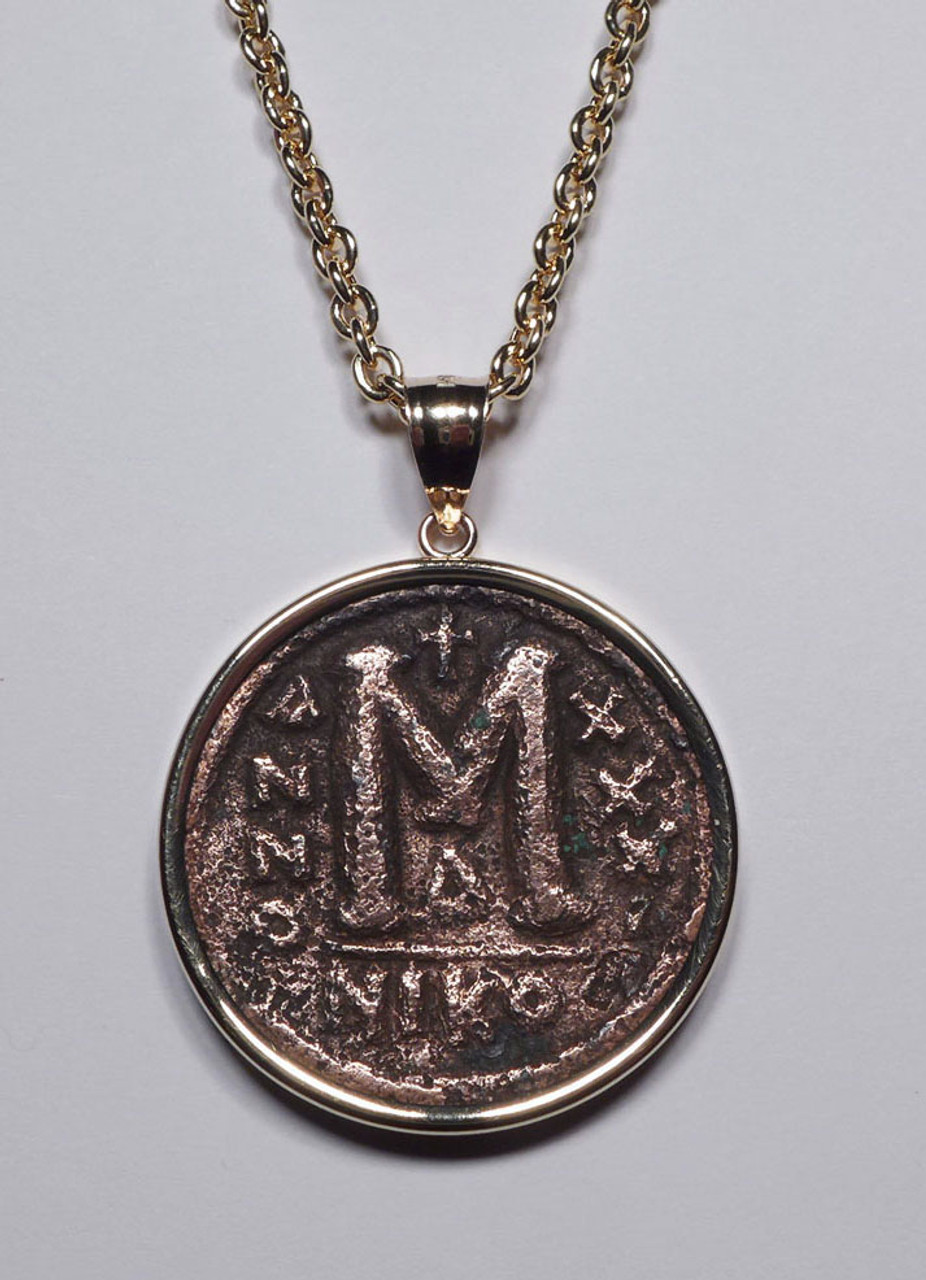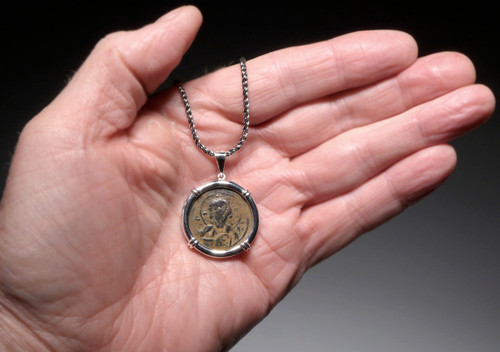Product Description
This large and impressive 14kt gold necklace pendant features a genuine ancient bronze Roman Byzantine follis coin that was minted during rule of emperor Justinian I, from 557 - 558 AD. Also known as Justinian the Great, there was no emperor who achieved more or served in a greater role during the lengthy history of the Late Roman Byzantine Empire than that of Justinian I. His achievements were many (see more history below) but one of his greatest accomplishments was the construction of the iconic Hagia Sophia Christian cathedral (ancient Greek for 'Holy Wisdom').
This stunning large genuine ancient coin is set in a simple, stamped high-polished 14KT yellow gold pendant setting. The warm, copper and black patina hues of the ancient bronze coin perfectly compliments the warm yellow of the surrounding gold bezel pendant. This coin is mounted with the reverse side showing a prominent letter 'M' which means 40 nummi, the denomination of a one follis coin. The letters ANNO to the left stands for "Year of Reign of the Emperor" and the inscription to the right translates to the 31st year. A small cross is seen above the "M".
The back side of the pendant shows the obverse of the coin which would have been a face-on image of the emperor but this is poorly preserved and the image is barely perceptible.
Perfect for someone who has the letter "M" in their initials, for someone who just turned 40 years of age, or to commemorate an event or anniversary of either the 40th (the denomination of the coin) or the 31st year (the reign of the emperor on the coin, XXXI). The handsome appearance of this piece is easily worn by either a man or woman and would most certainly, make for a unique, unforgettable gift!
*** Chain is not included but may be purchased additionally, at the link below
GUARANTEE: ALL PURCHASES ACCOMPANIED WITH A WRITTEN GUARANTEE OF AUTHENTICITY
SETTING: 14KT YELLOW GOLD
COIN: BRONZE FOLLIS
COIN AGE: 557 - 558 A.D.
DIMENSIONS: 1.25" or 31 mm overall diameter
:::: Includes Gift Box
:::: Includes CERTIFICATE OF AUTHENTICITY / HISTORY SHEET
ADD THE DISPLAYED THICK FORSANTINA 14K GOLD CHAIN
SEE MORE ANCIENT BYZANTINE ROMAN COIN JEWELRY
HISTORY
Justinian I, also known as Justinian the Great, was Eastern Roman emperor from 527 to 565. One of the most spectacular features of Justinian's reign was the recovery of large stretches of land around the Western Mediterranean basin that had slipped out of Imperial control in the 5th century. As a Christian Roman emperor, Justinian considered it his divine duty to restore the Roman Empire to its ancient boundaries. Although he never personally took part in military campaigns, he boasted of his successes in the prefaces to his laws and had them commemorated in art.
His legacy includes the uniform rewriting of Roman law, the Corpus Juris Civilis, which is still the basis of civil law in many modern states. He passed laws to protect prostitutes from exploitation and women from being forced into prostitution. Rapists were treated severely. Further, by his policies: women charged with major crimes should be guarded by other women to prevent sexual abuse; if a woman was widowed, her dowry should be returned; and a husband could not take on a major debt without his wife giving her consent twice. Family legislation also revealed a greater concern for the interests of children. This was particularly so with respect to children born out of wedlock. The law under Justinian also reveals a striking interest in child neglect issues. Justinian protected the rights of children whose parents remarried and produced more offspring, or who simply separated and abandoned their offspring, forcing them to beg.
Justinian's reign also marked a blossoming of Byzantine culture, and his building program yielded works such as the great cathedral Hagia Sophia. Hagia Sophia was originally built as the state church of the Roman Empire between 532 and 537 AD. It was then the world's largest interior space and among the first to employ a fully pendentive dome. It is considered the epitome of Byzantine architecture and is said to have "changed the history of architecture". It remained the world's largest cathedral for nearly a thousand years until Seville Cathedral was completed in 1520. Beginning with subsequent Byzantine architecture, Hagia Sophia became the paradigmatic Orthodox church form, and its architectural style was emulated by Ottoman mosques a thousand years later. It has been described as "holding a unique position in the Christian world" and as an architectural and cultural icon of Byzantine and Eastern Orthodox civilization.
As a result of the Byzantine coinage reform carried out at the end of the fifth century AD, a whole new range of denominations was brought into being each clearly marked with it’s value as a multiple of the basic ‘nummus’. The Christian religion that permeated the Byzantine culture influenced decisions to use Greek numerals for the new coins as Greek was the language of the New Testament. The largest denomination, the FOLLES, bore the mark of value “M” (40 nummi), the HALF FOLLES “K” (20 nummi), the DECANUMMIUM “I” (10 nummi), and the PENTANUMMIUM “E” (5 nummi), introduced at a later period. Over time, imagery used on the Byzantine coinage became increasingly religious. A portrait of Christ first appears on coinage of Justinian II (685-695 AD). Religious images were later banned in 815 AD during the Iconoclastic Period but restored in 843 AD under the empress Theodora.
.
 US Dollars
US Dollars
 AUD
AUD
 CAD
CAD
 POUNDS STERLING
POUNDS STERLING












